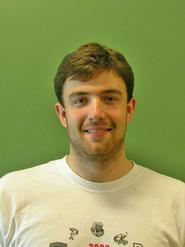
Greg Hartt '08 is working on two computational chemistry projects with George Shields, the Winslow Professor of Chemistry, and Visiting Assistant Professor of Chemistry Karl Kirschner this summer.
For one project, Hartt, a chemistry major, is studying water clusters and how they interact with sulfur species. Carbonyl sulfide (OCS) is a sulfur molecule that binds to different numbers of water molecules and plays an important role in the formation of acid rain. The purpose of the project is to provide geometries, energies, and vibrational frequencies for different structures in hopes that experimental chemists can find them spectroscopically. Hartt inherited the project from Tim Evans '05 who was looking for examples in which clusters of gaseous water catalyze sulfur reactions in the atmosphere. Hartt worked with Evans in Shields's lab as a pre-freshman in the STEP program and has continued work on the project each summer since. This project is nearing its end at Hamilton and Hartt's goal is to write a paper for publication in the near future.
Hartt's second project involves studying a box model of the atmosphere. The project uses a computer program that takes a model of a piece of the atmosphere and "bombards it with photons [or UV light] and measures the concentrations of the resulting particles," said Hartt. Hartt then puts the results into another program which runs 5,000 reactions and 2,000 chemical processes. This "gives us a view of how different reactions compete with each other in the atmosphere," said Hartt. The box model project is new to Hamilton students, but has been in development and use for several years. Hartt's goal is to improve the model and add in his own work with water clusters.
Hartt says the most difficult part of his research is learning about the box model project because it is unlike any other research he has done. "The box model project is completely different than anything I've ever done before. I have to learn computer programming for it," said Hartt, who hopes to go to graduate school for chemistry after graduating from Hamilton. But he enjoys working in the computational chemistry lab. "What we're doing is something completely new, no one has ever done it before," he said.
During the regular academic year, Hartt is a resident advisor, on the track and field team, and a member of the Tau Kappa Epsilon fraternity.
--by Laura Trubiano '07
Posted July 21, 2006
